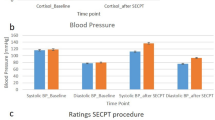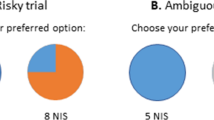Abstract
We successfully manipulated decision confidence in a probabilistic prediction task by means of stress as induced by excessive cognitive demands. In particular, our results indicate that decisions (based on high and low, but not intermediate levels of uncertainty) made under stress (confirmed by skin conductance measures) are associated with increased confidence when outcome probabilities are incompletely known (20% residual uncertainty). A different pattern was found when outcome probabilities were completely known (0% residual uncertainty). Here, stress led to decreased decision confidence when decisions were associated with intermediate levels of uncertainty but had no effect in case of high and low levels of uncertainty. In addition we provide evidence for ambiguity—(understood as implicit-risk) assessment being impaired under stress conditions.





Similar content being viewed by others
References
Adams, J. K., & Adams, P. A. (1961). Realism of confidence judgments. Psychological Review, 68(1), 33–45.
Arnsten, A. F. (2009). Stress signaling pathways that impair prefrontal cortex structure and function. Nature Review Neuroscience, 10(6), 410–422.
Bacon, S. J. (1974). Arousal and range of cue utilization. Journal of Experimental Psychology, 102, 81–87.
Baranski, J. V., & Petrusic, W. M. (1998). Probing the locus of confidence judgments: Experiments on the time to determine confidence. Journal of Experimental Psychology: Human Perception and Performance, 24, 929–945.
Baranski, J. V., & Petrusic, W. M. (1999). Realism of confidence in sensory discrimination. Perception & Psychophysics, 61(7), 1369–1383.
Cumming, S. R., & Harris, L. M. (2001). The impact of anxiety on the accuracy of diagnostic decision-making. Stress & Health, 17, 281–286.
Darke, S. (1988). Anxiety and working memory capacity. Cognition and Emotion, 2, 145–154.
Fessler, D. M. T., Pillsworth, E. G., & Flamson, T. J. (2004). Angry men and disgusted women: An evolutionary approach to the influence of emotions on risk taking. Organizational Behavior and Human Decision Processes, 95, 107–123.
Festinger, L. (1943). Studies in decision: I. Decision time, relative frequency of judgment and subjective confidence as related to physical stimulus difference. Journal of Experimental Psychology, 32, 291–306.
Fischhoff, B., Slovic, P., & Lichtenstein, S. (1977). Knowing with certainty: The appropriateness of extreme confidence. Journal of Experimental Psychology: Human Perception and Performance, 3(4), 552–564.
Garrett, H. E. (1922). A study of the relation of accuracy to speed. Archives of Psychology, 56, 1–105.
Gatternig, J., & Kubinger, K. D. (1994). Erkennen von Meta-Regeln. Test: Software und manual. Frankfurt/M: Swets.
Gorn, G. J., Pham, M. T., & Sin, L. J. (2001). When arousal influences ad evaluation and valence does not (and vice versa). Journal of Consumer Psychology, 11, 43–55.
Griffin, D. W., & Tversky, A. (1992). The weighing of evidence and the determinants of confidence. Cognitive Psychology, 24, 411–435.
Harkin, B. L., & Mayes, G. M. (2008). Implicit awareness of ambiguity: A role in the development of obsessive-compulsive disorder. Behaviour Research and Therapy, 46(7), 861–869.
Hockey, R. (1973). Changes in information-selection patterns in multisource monitoring as a function of induced arousal shifts. Journal of Experimental Psychology, 101, 35–42.
Huettel, S. A., Song, A. W., & McCarthy, G. (2005). Decisions under uncertainty: Probabilistic context influences activation of prefrontal and parietal cortices. Journal of Neuroscience, 5, 3304–3311.
Humphreys, M. S., & Revelle, W. (1984). Personality, motivation and performance: A theory of the relationship between individual differences and information processing. Psychological Review, 91, 153–184.
Johnson, D. M. (1939). Confidence and speed in two-category judgment. Archives of Psychology, 241, 1–52.
Johnson, E. J., & Tversky, A. (1983). Affect, generalization, and the perception of risk. Journal of Personality and Social Psychology, 45, 20–31.
Keinan, G. (1987). Decision making under stress: Scanning of alternativesunder controllable and uncontrollable threats. Journal of Personality and Social Psychology, 52, 639–644.
Kepecs, A., Uchida, N., Zariwala, H. A., & Mainen, Z. F. (2008). Neural correlates, computation and behavioural impact of decision confidence. Nature, 455, 227–231.
Klein, G. (1996). The effect of acute stressors on decision making. In J. E. Driskell & E. Salas (Eds.), Stress and human performance, 49–88.Mahwah. Erlbaum: NJ.
Leith, K. P., & Baumeister, R. F. (1996). Why do bad moods increase self-defeating behavior? Emotion, risk taking, self regulation. Journal of of Personality and Social Psychology, 71, 1250–1267.
Lerner, J. S., & Keltner, D. (2001). Fear, anger, and risk. Journal of Personality and Social Psychology, 81, 146–159.
Mano, H. (1994). Risk-taking, framing effects, and affect. Organizational Behavior and Human Decision Processes, 57, 216–245.
Moore, D. A., & Healy, P. J. (2008). The trouble with overconfidence. Psychological Review, 115(2), 502–512.
Pham, M. T. (1996). Cue representation and selection effects of arousal on persuasion. Journal of Consumer Research, 22, 373–387.
Pham, M. T. (2007). Emotion and rationality: A critical review and interpretation of empirical evidence. Review of General Psychology, 11(2), 155–178.
Rugg, M. D., Mark, R. E., Walla, P., Schloerscheidt, A. M., Birch, C. S., & Allan, K. (1998). Dissociation of the neural correlates of implicit and explicit memory. Nature, 392, 595–598.
Sachdev, P. S. (2005). Obsessive–compulsive behaviour: A disorder of decision-making. Australian and New Zealand Journal of Psychiatry, 39, 757–763.
Sanbonmatsu, D. M., & Kardes, F. R. (1988). The effects of physiological arousal on information processing and persuasion. The Journal of Consumer Research, 15(3), 379–385.
Schaeffer, M. H. (1989). Environmental stress and individual decision-making: Implications for the patient. Patient Education and Counseling, 13(3), 221–235.
Vickers, D., & Packer, J. (1982). Effects of alternating set for speed or accuracy on response time, accuracy and confidence in a unidimensional discrimination task. Acta Psychologica, 50, 179–197.
Walla, P., Endl, W., Lindinger, G., Deecke, L., & Lang, W. (1999). Implicit memory within a word recognition task: an event-related potential study in human subjects. Neuroscience Letters, 269(3), 129–132.
Williamson, G. F. (1915). Individual differences in belief, measured and expressed by degrees of confidence. The Journal of Philosophy, Psychology and Scientific Methods, 12(5), 127–137.
Acknowledgments
We want to thank Nikolaus Scholik from Hogrefe Austria for providing us with the physiological recording device Nexus 10 produced by Mind Media (BV).
Author information
Authors and Affiliations
Corresponding author
Rights and permissions
About this article
Cite this article
Heereman, J., Walla, P. Stress, Uncertainty and Decision Confidence. Appl Psychophysiol Biofeedback 36, 273–279 (2011). https://doi.org/10.1007/s10484-011-9167-9
Published:
Issue Date:
DOI: https://doi.org/10.1007/s10484-011-9167-9




